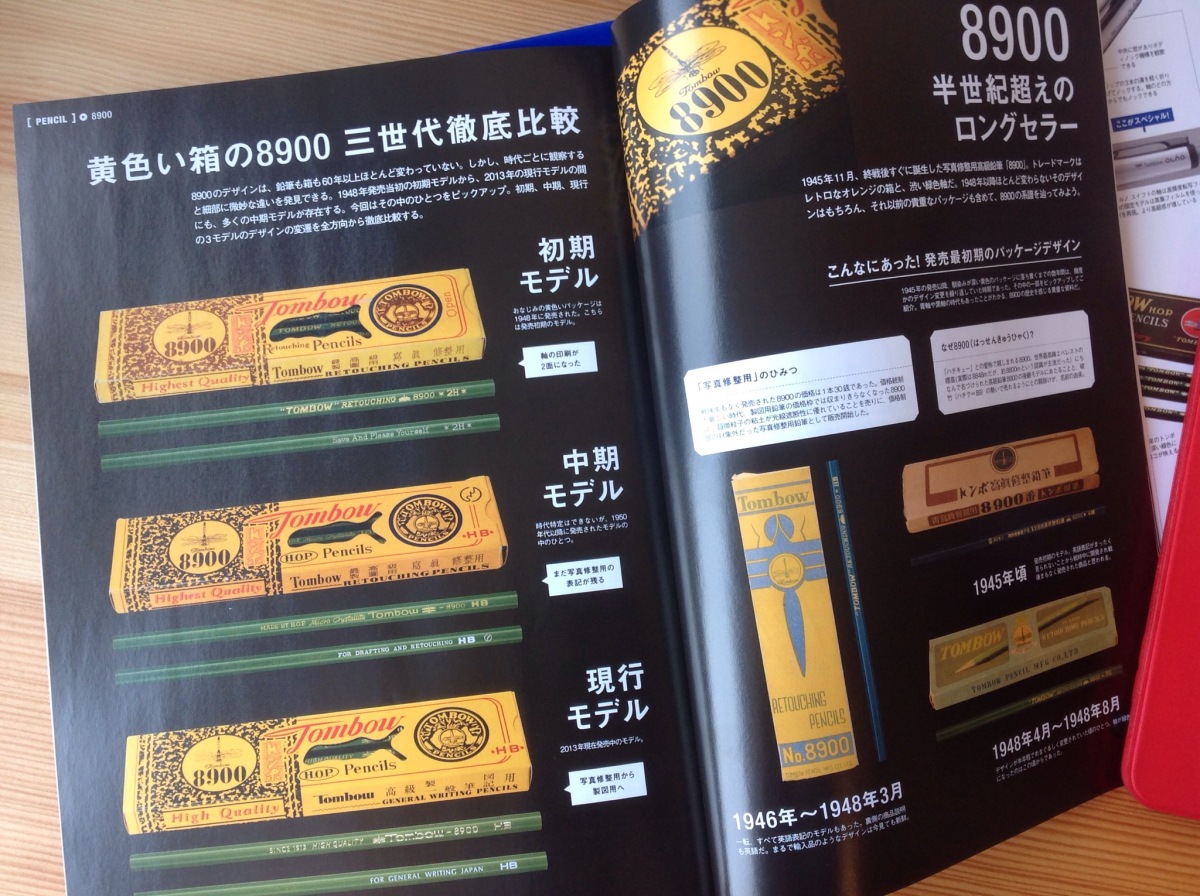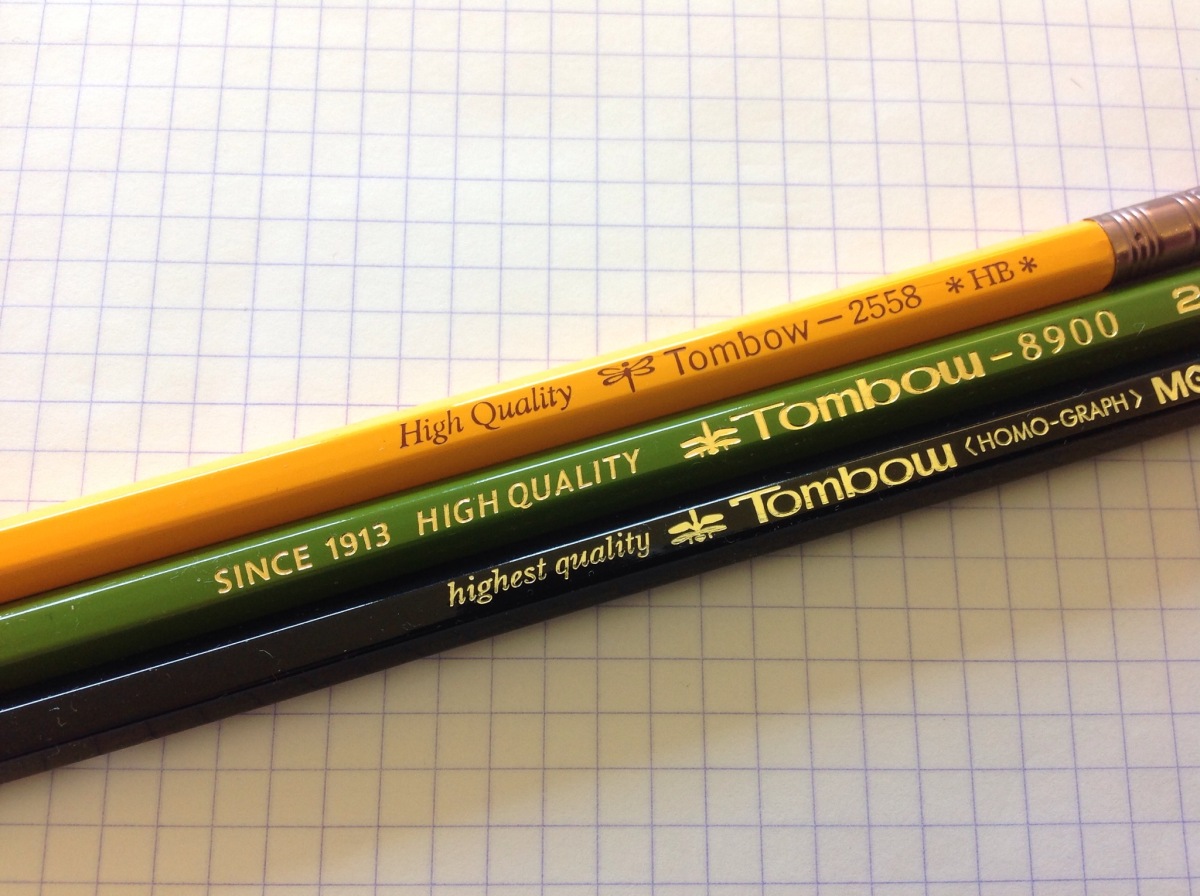Last week I got a surprise gift in the mail – a good friend in Japan was kind enough to send me her “Tombow Perfect Book”, published in commemoration of Tombow’s hundredth anniversary in 2013. The book is actually a special edition put together by Ei Publishing, a house that specializes in various lifestyle and hobby magazines, and well known to stationery geeks through its magazine Shumi no Bungubako (趣味の文具箱). I am not sure if Tombow has published its own definitive commemorative issue – it may be different from what I have.
It consists of a book and three pencils reproduced in the first-generation vintage style (but with current Mono 100 lead), an Olno mechanical pencil and an eraser also printed in the vintage style.
With a book of this nature you can’t escape the adoring blurb, but nevertheless there are some very interesting bits of information. I note some below – my apologies if the post is a bit more scattered and “bullet-point” than usual.
First, the nomenclature among the various Monos (first introduced in 1963): Mono J stands for “junior”, R for “regular”. The Junior (4H~4B) is at the lowest end of the Mono spectrum, intended for students and office use. The Regular(2H~6B) is of higher quality but has the same customer base.
The Mono 100 (9H~6B) is so named because there are 10 billion particles (100 oku (億) in Japanese) per one square millimeter in the lead. (The Mono had 8 billion per square millimeter.)
Oh, and of course “Tombow” in Japanese means “dragonfly”, hence the dragonfly logo – everybody knew that, right? ;)
One of the most incredible things about Japanese classic pencils is that they were designed by the most famous industrial designers of their day. The Mitsubishi Uni had Yoshio Akioka, designer of the Asakaze bullet train. The Tombow Mono 100 had Takashi Kono, of the Olympic design committee(1964) and the Japanese pavilion at the Osaka World Fair (1970). This may be one reason that Japanese pencil designs change so rarely, if at all.
The 8900 (introduced in 1945 and nicknamed “hachi-kyu” after its first two digits) was so named because it was the follow-up model to the 8800, which in turn was named after the height of the Everest. They also considered the number to be a good omen since “89” could also be a homonym for “破竹 (hachiku)の勢い”, which describes an unstoppable force such as that of splitting bamboo, and therefore they hoped the pencils would sell in such a manner. The 8900s had “Highest Quality” written on them up until the moment the Mono made its entrance – from then on it was demoted to “High Quality”.
During the Second World War, English was deemed an “enemy language” and pencils were graded using Chinese characters. H was “硬”(hard), B was “軟”(soft) and HB was “中庸”(middle-of-the-road, balanced).
Tombow pencils improved in tandem with imported machinery from America. Machines such as the speed-line mill and grooving and slatting machines, imported in 1950, made the Mono possible. The yellow 2558 came into being thanks to an eraser-and-ferrule machine, also imported from the US. (In the book, there are pictures of vintage Tombows with big, round ferrules identical to old Eberhard Fabers!)
Current Tombow pencils use mostly German clay, Chinese graphite and Californian incense cedar.
One final interesting tidbit: you know how many Japanese pencils have this innocuous but completely pointless imprint saying “For General Writing”? I always wondered about that, and up till now I thought it was because of this Japanese tendency to overdesign everything (e.g. cannot leave a blank space alone), but at least for the Tombow 8900 there seems to have been a definite reason. Because it was released right after the war, it was subject to price controls, and the manufacturing costs of the 8900 meant that it could not be priced within the limits set for drafting pencils. So Tombow opted to classify it as a “photo retouching pencil”, which was not subject to the same kind of controls, and so for some time after that the pencils carried the legend “retouching pencils”, and, later on, “for drafting and retouching”. After price controls disappeared and the usage evolved, I guess they changed the wording rather than to take it out altogether.
During the “golden age” of Japanese pencils, in the early 60’s, they produced seven times as much pencils as they do now. It was not only the volume; looking back, I think we can see in the pencils the immense optimism and faith in the dawning prosperity of their age, their growing confidence. Japanese pencils improved and matured exactly in tandem with their own economy, and the rivalry between Mitsubishi and Tombow gives you a sense of the heady one-upmanship of that time: the Tombow Homo-Graph came out in 1952, the Mitsubishi Uni in 1958, the Mono in 1963, the Hi-Uni in 1966 and the Mono 100 in 1967.
Pencils like the Mono and the Uni survive at least in part because their customers retain these positive cultural associations; in many instances I sense more than a whiff of nostalgia. Of course the consistent quality has helped, and the companies have proved adept at developing new products and markets in order to survive long after the heyday of pencils has passed. But I do hope that we won’t have to wait for another Japanese economic boom for a new premium pencil to be introduced…






Wow! Thank you for showing these items and for the exciting details. I especially like the one about the “For General Writing” imprint :-)
LikeLike
You’re welcome! BTW is this the same book you have or do you have something different?
LikeLike
The book I have mentioned is different – it’s entitled “The 100 Year History of Tombow Pencil”, is in A4 and has about 100 pages.
LikeLike
I think what you have is the official book or catalogue. Mine is about 130 pages and is definitely a “magazine”. Enjoy it for me and if there’s a particularly intriguing page, send me a picture and I will translate it for you :)
LikeLike
Yes, I have the official book. Thank you for offering me your help with translating but fortunately I have the English copy :-) – Your magazine is about 130 pages? Wow! Is it still available?
LikeLike
I would be surprised if it were – it came out in March 2013, and on the publisher’s homepage it is listed as “sales terminated”. Well it is 130 pages but it had only a few pages on pencils – the table of contents will give you an idea.
BTW was there any information like this in the official book or was it more like a straightforward company history?
LikeLike
Splendid, Sola, very informative. Presumably, Akioki and Takashi did not envision the modern disfigurement to their designs of barcodes. Likewise, “retouching” and “for general writing” sounds like Tombow’s decision, not Akioki’s. Commerce trumps good design sense, sadly. So long as the tradition of writing in Japanese culture is revered–you once observed that writing is a sacred act in Japan–then, perhaps the long march to excellence which has been the hallmark of the rivalry between Tombow and Mitsubishi will continue, even as domestic manufacture is long past its zenith in most if not all developed economies. If the developed world is post-peak-pencil, where will the demand for new premium pencils arise? Frankly, I don’t see Japan recovering anytime soon from its decades-long economic malaise. If the so-called economic miracles in China and India are more real than apparent, and steady organic growth of a middle class which is as pencil-minded as the Japanese obtains, there is where we might see new demand. And wouldn’t that be ironic, the bastion of pencil-dumping saving the premium pencil?
LikeLike
Yes that’s possible, and what’s more, Japan used to be one of them some generations ago ;) They say it was the shock at seeing how poorly Japanese pencils were regarded overseas that prompted Mitsubishi to get to work developing what eventually became the Uni. However, I don’t think Japan can be written off so easily in pencil terms, at least not yet. First of all is that it doesn’t seem that easy to make a really, really good pencil, and here the established manufacturers are at a distinct advantage. And secondly, although the overall economy may still languish, there seems to be a “stationery boom” of sorts happening in Japan – while the market for stationery is actually contracting (big companies cutting down on office supplies etc.), stationery aimed at the individual consumer is selling well. Stationery stores are expanding, and the industry is attracting new talent. So I think there is still a chance that an interesting new pencil will come out of Japan in the near future. I’m not hoping for anything as big as the Uni or the Mono, but I’d like to see a really nice, well-made pencil, in the manner of the Caran d’Ache Swiss Wood or the Graf von Faber-Castell Perfect Pencil :)
LikeLike
Somewhat related, I have recently seen a music video here in the U.S. which was filmed on location in a well-to-do prefecture in what I assume is Tokyo which features a young Japanese girl in her bedroom, going to the fish market, riding her scooter. The camera doesn’t linger, but on the desk in her room is jar after jar of woodcased pencils, and she is clearly drawing with a Mars Lumograph (which she probably bought at Bundoki on one of her sojourns).
LikeLike
Oh, I suppose blue agreed with the overall color scheme of the video, rather than black or azuki-bean red? ;) There does seem to be a lingering fascination with foreign-made stuff, even when Japan has more than caught up. And Faber-Castell and Staedtler seems to have been two of the most important examples :)
LikeLike
Great insights about Tombow pencils, thanks for sharing them.
Lovely surprise gift. Just like Christmas when it comes early, I bet :)
LikeLike
Thank you for your kind words, P, but my insight isn’t much and most of the text is just straight translation ;) And yes, I got a lot more parcels than I really deserved during the past two weeks, I’m already bracing for the dry period in December! Hope your holidays are filled with pencils too :)
LikeLike
Oh… but they will be indeed :)
Just yesterday I finally received my first batch of mitsubishi hi-uni and tombow pencils. i was hoping to get them for my birthday but customs delayed it to 3 days after.
I could not help selecting a few to start writing with right then, but the rest of them I have nicely wrapped for Christmas – along with a few extra goodies.
Bem haja!
LikeLike